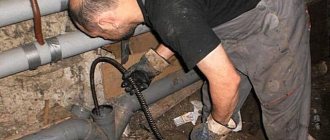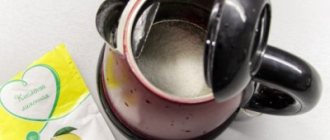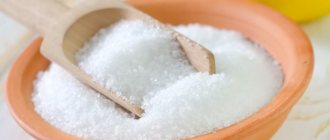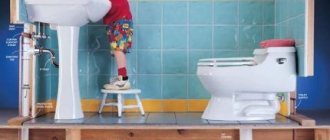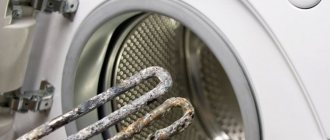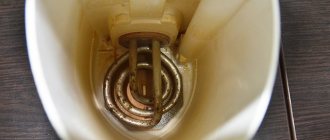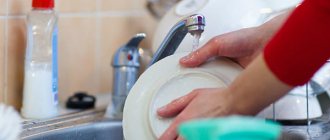The most effective ways to remove blockages in sewer pipes are mechanical and hydrodynamic cleaning. But to carry out such procedures, you often need to call a specialist. If only because of the lack of the necessary tools at home. Therefore, enterprising people often use folk remedies to clean pipes with citric acid.
This solution cannot be called extremely effective, but there is some benefit from it. Therefore, today we will tell you how to properly use citric acid to clean pipes. At the same time, let's talk about specific results that can be achieved using the mentioned cleaning method.
Causes of blockages
The main reasons causing problems in home sewerage include:
- Fat deposits. This is the most common problem with kitchen pipes - grease and other food debris gradually settle on the walls of the pipe, causing the formation of a “plug” with an unpleasant odor.
- Remains of hair, threads and other large contaminants.
- Rust that accumulates on the inside of a pipe.
- Limescale sediment. This cause is often found in areas where the water has a high lime content.
Cleaning away limestone deposits
To ensure that risers do not deteriorate from the inside, are used for a long time, do not reduce thermal conductivity, and also have an attractive appearance, it is necessary to regularly clean them of limestone deposits.
Mechanical and chemical cleaning are considered not very effective, since during their implementation the surface metal layer is destroyed. Plus, during such cleanings it is sometimes necessary to dismantle the system, which is not always pleasant, and from a financial point of view it is not very profitable. In addition, if you use chemical cleaning, you should strictly follow the instructions. Otherwise, you can not only harm yourself, but also harm the environment. Although, many people prefer these methods of protection against scale.
To carry out automated cleaning of pipes from rust and limestone deposits, use:
Compressor for purging
- compressor;
- automatic pump;
- high pressure devices.
With the help of a water or air jet supplied by these mechanisms under high pressure, limestone deposits are torn off the internal surfaces of the pipes and come out.
Using even the best methods and methods for removing scale in pipes, some of the metal is removed along with pieces of plaque. Therefore, it is better to prevent clogging of structures, for which it is necessary to regularly carry out preventive measures in order to eliminate the possibility of scale formation.
Important! The cost of preventative work to prevent the formation of limestone deposits is much cheaper than the process of cleaning a contaminated pipeline system.
We remove scale from plastic and copper pipes
Nowadays, copper and plastic pipes are the most common structures that are used both in apartments and in private premises. Copper analogs are used in heating, gas supply, and air conditioning systems. Plastic risers are used in water supply, sewer, and other mains. During operation, all risers, regardless of the material of manufacture, become covered with limescale. So, how to clean copper and plastic pipes from scale?
Both types of pipelines have their own advantages and disadvantages. But what they have in common is the impact of working environments in the form of precipitation, which must be periodically disposed of.
Therefore, scale in copper and plastic pipes and its cleaning is a serious problem for this equipment.
It should be remembered that reagents and devices that can be used to clean sediment from copper pipelines cannot be used to remove contaminants from plastic pipes. For example, chemical cleaning with acids is suitable for copper products. But if you use the same reagents to clean risers from other materials, then plastic, for example, may simply melt. Therefore, before starting the procedure for ridding pipes of contamination, you should correctly decide on the choice of mixtures, tools, and devices.
Getting rid of plaque using ultrasound
An ignorant person may think that ultrasonic descaling of pipes is a joke or a prank. How can ultrasound affect scale? But don't rush to conclusions. First things first.
It turns out that ultrasound not only softens water better than any reagents, but also cleans pipes of scale. How is scale practically removed using ultrasound?
The main advantage of the ultrasonic method is that after removing scale from pipes, they are no longer deposited on the inner surface of the pipe.
With the help of ultrasound, exposure is carried out in several ways simultaneously:
1. Salts are destroyed throughout the entire thickness of the water and it is purified, which eliminates the possibility of deposits on the walls. After all, it is known that scale forms when hard water comes into contact with a hard surface. It is on this property that the action of ultrasound is based, under the influence of which many crystallization centers begin to form throughout the entire water column. Since suspended particles have a larger area compared to the areas of warm surfaces, scale formation begins to occur as a result.
Under the influence of ultrasound, hardness salts split and their structural changes begin to occur. After this procedure, the size of salt crystals decreases by about 10 times. As a result, the surface area of all hardness salts increases by the same amount. Thanks to the presence of these small particles (their size is about 1 micron!), crystallization centers begin to be created throughout the water column, but they do not stick to the pipes! You can’t say anything: smart, simple, reliable!
2. Hard water is also subjected to a second exposure to ultrasonic waves. The essence of this process: high-frequency ultrasonic vibrations are created in metal surfaces. Thanks to this property, the entire heating surface is subject to these vibrations, and at the same time, repels hardness salts from the inner surface of the pipe. Since the hardness of the sediment and metal layers is different, ultrasonic vibrations passing through the heat-heating surface contribute to the gradual removal of old scale in the pipes. Thus, under the influence of ultrasonic waves, scale peeling is observed, pieces of which begin to be washed out of the equipment.
Cleaning with hydrochloric and citric acid
High-quality chemical cleaning of water and other pipes requires the presence of strong chemical reagents or products with components that must be properly diluted with water and poured into the pipe. Such mixtures can destroy any scale.
Hydrochloric acid is a very strong reagent. It is necessary to clean steel or cast iron risers with its help very carefully, since such a chemical descaling agent can greatly harm old pipeline structures. There have been cases where, as a result of a chemical reaction, through holes were formed in the iron.
When using hydrochloric acid to descale pipes, one should not forget to comply with safety regulations. Before starting work, you need to make sure that the room is well ventilated. After all, not only acid fumes are dangerous, but also gases that will be released during operation. Also, it is necessary to protect your eyes, hands, and respiratory organs from the possible influence of the chemical substance.
Work should begin with a solution of 5-10% concentration. If you do not achieve the desired result, you should increase the amount of acid.
Important! It is not recommended to use a hydrochloric acid solution with a concentration greater than 33-35%, otherwise the pipes may be damaged. The end of the washing process, which can last 3-4 hours, is indicated by the absence of foam. The used solution should be poured into an unnecessary container, neutralized with lime and poured in small portions in a remote, remote corner where no one walks.
Important! After chemical cleaning of pipes, you need to rinse them with plenty of water until you are sure that the chemicals are completely washed away. In terms of its popularity and effectiveness, citric acid is almost in no way inferior to hydrochloric acid. It is used to clean pipes from scale both in industry and at home.
But such a reagent should be used with some restrictions:
- it is necessary to take into account that the solution should be prepared in the following ratio: one percent per millimeter of limestone plaque;
- When working with a descaling agent such as citric acid, you should not use enamel and aluminum cookware, as you can be poisoned by harmful substances that will be formed after a possible chemical reaction.
Important! The concentration of citric acid solution should be in the range from 3 to 10%. A composition with a higher reagent capacity can burn through not only the formed scale, but also the surface of the pipe. Plus, cleaning pipes from scale with citric acid does not involve the use of solutions less than 3% concentration, since such a mixture can only partially dissolve the scale.
Types of clogged home drains
There are several types of sewer blockages:
- Operational. They arise as a result of the appearance of a “plug” consisting of microscopic particles of various contaminants. The first sign of such a blockage is slowly draining water in the sink.
- Mechanical. They appear due to foreign objects or large contaminants getting into the pipes. In this case, the water leaves very little or does not leave at all.
- Siphon. They arise due to blockage of the siphon, an element of the sewer system.
- Technological. The most complex type of blockage that occurs due to improper installation of pipes or their wear. Removing technological blockages is only possible by dismantling the old pipe.
Professional cleaning
If you cannot normalize the functioning of the sewer system on your own, then it is recommended to seek the help of professionals. In their work they often use a powerful hydrodynamic device. It is a large diameter rubber pipe with a special tip attached to the end. Water is passed through it under enormous pressure (minimum 190 MPa). It has a powerful effect on the traffic jam and quickly removes it. Such equipment allows you to wash the most inaccessible places, very long pipes, including yard sewerage.
Professional devices include a special machine for removing blockages. It can be sectional or drum type, providing the opportunity to efficiently clean any type of sewer pipes. A simple option is a powerful unit that runs on gasoline. It is easy to move around the building, as well as around the local area.
For professional cleaning of the sewer system, several methods are used, requiring the use of special equipment and the involvement of trained specialists Source 771001.ru
How to break through a blockage with soda?
If the “plug” is not strong (water flows out, but weakly), you can try to break through the blockage with soda. For this:
- Pour 2-3 liters of boiling water down the drain.
- Then add 2 cups of baking soda. After that, pour 1 liter again. boiling water You need to pour in a thin stream so as not to wash all the powder out of the drain.
- Wait 15 minutes. Then pour in 2 liters again. boiling water, pour in with strong pressure.
For “light” blockages, this method helps to quickly “break through” and dissolve the resulting plug.
See also: Cleaning a washing machine with soda - is it worth a try?
FAQ
People often have the following questions:
Can toilet paper cause a clog?
Of course, toilet paper that does not dissolve in water should not go down the drain. To prevent blockages, sewer pipes are cleaned several times a month.
Is it possible to use several chemicals at the same time to enhance the results?
Experts do not recommend doing this, since individual components may react with each other, the result of which will be unpredictable. There are risks of vapor intoxication, as well as burns of mucous membranes and skin.
What to do if there is no plunger, but you need to break through the blockage urgently?
A 2 liter plastic bottle will come to the rescue. You need to screw the lid tightly and cut off the bottom along the edge. Then use the homemade device in the same way as a plunger. After use, the bottle should be thrown away immediately and the toilet itself should be disinfected.
In conclusion, it is worth noting that a clogged toilet is a problem that can affect absolutely anyone. The main thing in this matter is to react quickly and take measures to clean the sewer pipe. If it is extremely difficult to do this with the help of improvised means, you should seek help from specialists.
Soda and vinegar for cleaning pipes - instructions
To clear a clogged sewer pipe, use these instructions for using baking soda and vinegar:
- Take 1 pack of regular baking soda. Pour about half the package of dry powder down the drain. Do not mix with water.
- After pouring the baking soda, pour 1/2 cup of acetic acid into the drain hole. To achieve a better effect, the vinegar can be slightly heated beforehand.
- As soon as the vinegar is in the drain hole, plug the drain with the prepared rag. This is necessary to prevent foam resulting from the reaction from escaping. When they react, soda and vinegar for cleaning pipes form an alkaline environment, accompanied by abundant foam, which acts as a “punch” for the blockage. Therefore, it is very important that the reaction takes place inside the pipe.
- Leave the product for 30-40 minutes. During this time, the alkali will completely dissolve organic contaminants, cleaning the drain.
- After 40 min. remove the cloth, pour 1 liter into the drain. boiling water Pour water slowly to completely unclog the drain and rinse away any remaining product.
Using soda and vinegar, you can effectively remove blockages of organic origin, which is especially important for kitchen pipes, where food residues from dishes constantly accumulate.
And here we have collected detailed material on how to clean grease from a hood with soda and vinegar.
Use of household chemicals
Special household chemicals give good results in clearing clogs. They are available in dry and liquid form.
When choosing a specific product, you need to consider:
- price;
- exposure time;
- convenience of packaging;
- release form;
- compound.
Disposable sachets are convenient because you do not need to measure the amount of the drug - the contents of the entire sachet are poured into the drain.
Bagi Pothan
Bagi is a trademark of an Israeli company. The product is available in the form of granules . Use the drug by pouring the required amount (about 100 grams per drain hole). After this, hot water is poured in according to the instructions.
The Pothan product is effective and has an aggressive effect, dissolving not only food waste in pipes, but also hair and even diapers. Bagi is used to clear blockages in metal and plastic pipes. Exposure time – 3 minutes. It should not be exceeded.
The price for a container of 600 grams is about 700 rubles. Read reviews here, here and here.
Sanfor
The product in gel form is intended for effective cleaning of sewer pipes. Thick in consistency, the gel easily penetrates the clogged area, despite the presence of water. Sanfor eliminates unpleasant odors, dissolves food contaminants and hair in the drain.
For one application, 0.25 liters of product is enough. The exposure time averages up to a quarter of an hour; for complex blockages, it can be increased. If the drug does not help the first time, the treatment can be repeated.
A container with a volume of 0.75 liters costs up to 200 rubles. Read reviews here, here and here.
Synergetic
The anti-clog product, like all the company’s products, is biodegradable and hypoallergenic . During exposure, it disinfects and eliminates unpleasant odors.
It should be used in its pure form, poured into the drain. Exposure time is up to 20 minutes. The drug can be used as a prophylactic agent; in this case, 0.25 liters per use is sufficient.
Synergetic is suitable for all types of pipes and can be used in the presence of a septic tank. Price – up to 200 rubles per container. Read reviews here, here and here.
Baking soda, salt and vinegar for cleaning drains
If the combination of baking soda and vinegar doesn't work, try something heavier by using a soda-vinegar solution combined with regular salt. This is an effective method that can remove even complex stains.
- Take 1/2 cup of baking soda powder and the same amount of table salt. Pour them into the drain hole.
- Pour a glass of acetic acid into the powder and cover the drain hole with a rag.
- Leave for 1-2 hours, then pour in 2-3 liters of boiling water to completely rinse the pipe.
While there is soda, salt and vinegar in the drain, you cannot use the drain.
What other compositions can be used
If a sewer pipe in the kitchen or bathroom is clogged at home, you can clean it with a slightly different composition, which contains soda. To create a sufficiently suitable ingredient you will need half a package of baking soda and the same amount of salt. Mix these products together and pour them down the drain, add hot water and leave for eight hours. It is advisable not to use the sewer at this time; therefore, removing the blockage should be done at night.
After the time has elapsed, open the line with cold water and check how it flows into the drain; when it is slow, you will have to use a plunger to clean the dissolved debris plug. This product is suitable for plastic and metal pipes. It can be used both for prevention purposes and to eliminate the problem. These methods will help solve other issues besides unclogging the kitchen sink.
You also use 1 cup of soda, pour it down the drain, then fill it with hot water and leave for about 40 minutes. Then simply wash off the composition in the pipe with plain water. If the plug of dirt that is clogged is small, then this method will be no less effective, otherwise it will be necessary to clean the system several times.
- Boiler room at home ► The gas water heater does not light up: the main causes of water heater failure and how to eliminate them
- Boiler room at home ► What to do if the sink is clogged? — methods of elimination and preventive measures to prevent contamination
- Boiler room at home ► Water flows from the tank into the toilet: the main causes of breakdowns and how to fix them yourself
- Boiler room at home ► Why the pumping station often turns on: reasons for equipment failure and ways to eliminate them
- Boiler room at home ► Choosing cables for cleaning sewer pipes, or how to clear the blockage yourself
- Boiler room at home ► Features of installing a pipeline from steel pipes, connection methods
- Boiler room at home ► Do-it-yourself polypropylene water supply: advantages of PP pipes, selection of parts, wiring methods, installation work
- Boiler room at home ► How to clean a sewer in a private house - cleaning methods and their features
- Boiler room at home ► The cesspool has silted up - what to do? Signs of siltation and cleaning methods
- Boiler room at home ► Replacing pipes in the bathroom
- Boiler room at home ► What to do and how to avoid blockages in sewer pipes and quickly clear the blockage in the sewer
- Boiler room at home ► Methods of water supply
- Boiler room at home ► How to drill a well with your own hands: types of wells and drilling methods
- Boiler room at home ► Laying out pipes in the bathroom with your own hands - developing a diagram, choosing a method for laying a water supply system, dismantling used pipes
- Boiler room at home ► SODA
SODA, see Sodium carbonate. Heating water supply boiler room LLC DESIGN PRESTIGE > https://resant.ru/ Telephone: 8(495)744-67-74 We provide installation services for heating and water supply systems for private country houses, dachas, organizations. We supply......
- Boiler room at home ► Sodium hydroxide (Sodium hydroxide, Caustic soda, Caustic soda)
Substance: Sodium hydroxide (Sodium hydroxide, sodium hydroxide, caustic soda) Code: 150 Ag. comp.: solidHazard class: 150 MPC s/s: n/dPK m/r: n/dBOV: 0.01 VOC: no Heating water supply boiler room LLC DESIGN PRESTIGE > https://resant.ru/……
- Boiler room at home ► Emulsol (mixture: water - 97.6%. sodium nitrite - 0.2%. soda ash - 0.2%. mineral oil - 2%)
- Boiler room at home ► diSodium carbonate (Sodium carbonate, Soda ash)
Substance: diSodium carbonate (Sodium carbonate, Soda ash) Code: 155 Ag. comp.: liquid/gas Hazard class: 155 MPC s/s: n/dMPK m/r: n/dOBV: 0.04 VOC: no Heating water supply boiler room DESIGN PRESTIGE LLC > https://resant.ru/ Telephone……
- Boiler room at home ► Methods for dismantling concrete
- Boiler room at home ► Methods of water supply at home
Caustic soda for drain cleaning
If baking soda doesn't help clear the clog or drain, use caustic soda, a caustic soda that quickly dissolves any organic contaminants.
- Shake the container with caustic soda without opening the lid.
- Take 2-3 tbsp. gel-like or granular substance, place it strictly in the drain hole.
- Pour in 1 cup of hot water and close the drain.
- Leave for 2 hours, then rinse the pipe with a strong stream of warm water.
When working with caustic soda, be sure to use rubber gloves and thoroughly ventilate the area.
Recommendations
When clearing blockages, plumbers advise listening to the following recommendations:
- Any wastewater system requires compliance with preventive measures.
- When working, it is necessary to organize good ventilation. This is necessary for several reasons. First, clogged drains have an unpleasant odor. Secondly, household drain cleaners are not only aggressive in their effects, but also release caustic substances into the air.
- If you are planning a renovation with the installation of plumbing, you need to choose responsible specialists.
- When replacing pipes, plastic ones are preferable to cast iron ones, as they have a smoother surface and are not prone to corrosion.
If you are interested in how to clear a clog in a pipe, sink or toilet, take a look at this section.
Mechanical methods for eliminating pollution in sewers
In addition to chemical cleaning methods, there are also mechanical methods of dealing with blockages:
- Plunger. When a plunger is used, a pressure difference is created in the pipe, which pushes the “plug” down the pipe, releasing the drain. A plunger can easily remove small blockages; in the presence of large accumulations of fat, a chemical cleaning method will be required.
- Plumbing cable. Used for hard blockages - using a thin and flexible cable, the “plug” is picked up and pulled out.
Why does grease settle on pipes?
Every day, when washing dishes and pouring leftover food into the toilet, a large volume of water containing fat impurities passes through the pipes. It is a mistake to think that they are completely dissolved by dishwashing detergents.
A large amount of fat remains and settles in the water supply and sewerage systems, turning into a sticky film that lines the inside of the pipes layer by layer. Over time, threads, hair, and other small debris stick to it and a dense plug is formed, through which complete drainage cannot be performed. The appearance of an unpleasant odor is a sure sign of a blockage.
This problem often appears if cast iron sewer pipes are installed in a house or apartment. The rough structure of the metal promotes the adhesion of fatty deposits to it. If we talk about modern polypropylene and PVC pipes, blockages in them are formed due to the deformation of the material during its long-term operation.
Favorable conditions for fat accumulation are:
- washing dishes in cold water;
- draining cooled soup or broth down the drain;
- washing pans and pots without using special products;
- improperly installed sewerage / plumbing.
To avoid fat accumulation, preventative measures must be taken periodically. If a blockage does occur, you can eliminate it yourself using simple methods and available means.
Reviews
Anton, 39 years old, Vladivostok. The kitchen drain pipe was regularly clogged. The result is a whole battery of expensive products in the closet and no sane result. Tired of the endless struggle with blockages, I decided to try cleaning the pipes using regular soda and acetic acid. The result was pleasing, although it took a long time to ventilate the kitchen from the smell of vinegar.
Valeria, 32 years old, Yekaterinburg. Previously, I always used store-bought products like Toilet Duck. When I realized that I was simply throwing away money (the pipes were practically not cleaned, there was always water in the sink), I decided to try traditional methods. I read about baking soda and vinegar to remove blockages. And it really works! I advise everyone - you will save money and remove the blockage.
Regular soda will help clean the inside of the kettle - read about it below.
Radical solutions to the problem
When the blockage cannot be eliminated using folk remedies and chemicals, you should try to deal with it using mechanical methods.
Option No. 1 – vacuum cleaner
You can use a vacuum cleaner to remove clogs. However, the device must have a blowing function. If you are the owner of such equipment, then first wrap the end of the device hose with a loose rag. It is very important to fix it well.
Press the hose firmly against the drain hole and turn on the vacuum cleaner to maximum. A powerful stream of air will push out the plug formed in the pipe.
It is necessary to install the device tube at a right angle, trying to press its end as firmly as possible against the drain hole
Using a vacuum cleaner is effective when the problem is no more than 1 meter from the drain hole.
Option No. 2 – plunger
To bleed the drain, use a plunger, which can be manual or mechanical. This device is sure to be found in every home. It helps create strong pressure inside the pipe, causing the blockage to break up or pump deeper.
While pumping, move the plunger back and forth without lifting the bowl from the drain. Do several approaches, and then remove the plunger and evaluate the effectiveness of the work. If the liquid drains slowly, you will have to repeat everything all over again.
Before working with a plunger, it is advisable to lubricate its edges with grease or Vaseline. This will ensure tighter contact with the sink.
Option No. 3 - plumbing cable
When a plug has formed on the bends of pipes or far away in communications, a plumbing cable is used. It can be used to hook and pull out a clog or clear it out.
The process of cleaning pipes with a cable begins with dismantling the siphon. Do not try to work the cable directly through the plumbing drain hole. Only by removing the siphon will you have free access to the sewer system.
After installing the cable in the pipe, begin to screw it clockwise, trying to slowly push it forward. Act smoothly and gradually, avoiding sudden movements.
There is a hook at the end of the cable, so use the device carefully when cleaning plastic pipes so as not to damage them
When you encounter resistance, turn the device until it continues to move. After this, you can put the siphon in place and flush the system.
Not everyone has a plumbing cable, but if you want, you can buy it at any plumbing store.
Read about the types of plumbing cables for cleaning sewers in this material.
In addition, you can build this device with your own hands from a plastic bottle and scrap materials.
The instructions are as follows:
- Cover the bottle from top to bottom with strips of tape to form a spiral.
- Draw lines along the border of the adhesive tape with a colored marker.
- Cut the bottle along the marks you made.
- Be sure to leave the bottom - it will act as a handle.
- Make small cuts along the resulting spiral.
- Insert a homemade cable into the drain and push it through, slowly holding it by the “handle”. Due to the notches, debris will cling to it, this way it will be possible to overcome the traffic jam.
This device is only suitable for plugs that are not too far from the siphon.
During sewer cleaning work, do not forget to periodically turn on the water. This will help you deal with contaminants faster
For blockages at great depths, steel wire with a diameter of 5-6 mm is used. One end of it is bent with a hook.
Option No. 4 - disassembling and cleaning the siphon
As was said at the beginning of the article, in 90% of cases the water does not pass beyond the sink due to a clogged siphon.
The cleaning procedure is as follows:
- Spread an unnecessary rag on the floor that absorbs water well. It should be directly under the siphon.
- Place a basin under the sink into which the liquid will subsequently be drained.
- Unscrew the lock nut that secures the siphon tube.
- Remove the siphon. Remove all dirt from it (this is convenient to do with a brush), and then rinse thoroughly under running water.
- Pour a solution of soda and vinegar into the pipe connected to the sewer. When the reaction is complete, pour in an additional 150 ml of vinegar. Repeat this procedure several times.
- After 15-20 minutes, pour several liters of hot water into the pipe and wait 5 minutes.
- Reinstall the siphon and tighten the lock nut.
As a rule, if you follow the instructions given, you will be able to deal with the blockage the first time.
